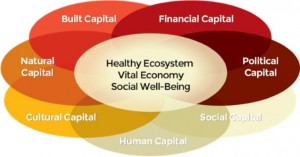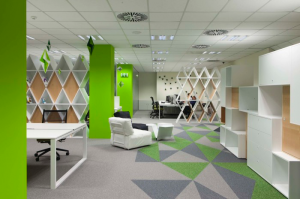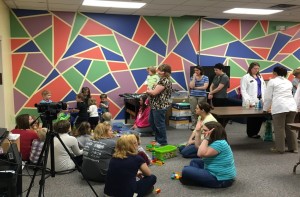We spend a lot of our lives at work. How can we more effectively foster engagement, collaboration, and promote an atmosphere of teamwork? One approach is to develop intentional, multi-purpose collaborative space, or work zones.
“Space” is constantly being re-defined and re-designed. A couple decades ago public spaces were being reclaimed and re-purposed to increase civic engagement. Then classrooms started transforming their space to increase student engagement and incorporate innovative technologies. Today, the places where we actually go to work (our work spaces) are in the spotlight of innovation and debate.

Community Capitals Framework Diagram: (agecon.unl.edu/cornhusker-economics/2015/community-capitals-framework)
There are dozens of new terms being used to describe innovative work spaces including, for example: smart work spaces, makers’ spaces, co-working spaces, projective spaces, engaged workplaces, and humanized spaces. Regardless of the term, the same principle stands; space impacts humans’ physical and mental capitals.
Effective work spaces can impact the upward mobility of our overall community capitals through our use of space, programming, and outreach efforts. The Harvard Business Review recently posted, “One of the things that environmental psychologists focus on is how design affects mood. Via a chain of psychological chain reactions, mood influences worker engagement; more positive moods link to higher levels of engagement. Designing for engagement is designing to make those positive moods more likely.” (Augustin, 2014)

Photo: the office of Siteground, designed by Funkt.eu. Photo by: Brava Casa, post on Swipes Personal Blog.
This topic is being studied by academia as well as creating a new niche for design professionals, like Funkt, which are reinventing workspaces and the reason Smart Workplace Design Summits are being held around the world. The evidence is growing for experimenting and breathing new life into our office spaces.
There is a growing demand for such work environments as new employees enter the workplace and seek out work spaces that are welcoming and inviting and promote a general sense of well-being. Comfortable work spaces promote an atmosphere of teamwork, keep minds focused and can limit distractions.

Spark Lab in Hardin County, OH. Photo by Mark Light. Welcome to the Sparks Lab
Mark Light (Hardin County Ohio 4-H Youth Development Educator and CED) has been involved in transforming his traditional office space into a dynamic makers’ space. Mark stated, “The goal of the Hardin County Ohio Spark Lab is to instill that inspiration or ‘spark’ that youth and adults need to discover, learn, and grow in a creative environment. This setting is more than just a futuristic classroom or makers’ space. It is a center of innovation in a rural county framed through the education lens of a land grant university system.” (Light, 2016)
The Hardin County Ohio Spark Lab makers’ space was made possible through a combination of funding sources: an OSU Extension Innovation grant, Columbus Foundation funding, and the Hardin County Commissioners. Sometimes, funding needs to be as creative as the spaces we are trying to create. These are exciting times to be working in!
Walk around your work space in the New Year and talk among your peers. See if creative steps and funding streams can be explored to make your work space more innovative and engaging for you, your colleagues, and your community’s benefit.
Meghan Thoreau is a new OSU Extension Educator in Community Development with a focus on providing leadership and programming to meet current and future needs related to STEM education with Pickaway County schools. Meghan grew up in Milwaukee, Wisconsin; is an avid traveler and has lived in a number of places, including Western Wyoming, Upstate New York, and Eastern South Dakota, before moving with her family to Central Ohio. She’s worked with communities both at the municipal and grassroots levels and has always strived to strengthen communities and increase the quality of life for residents.
Post References:
Augustin, Sally. (2014, October 28) Rules for Designing an Engaging Workplace. Harvard Business Review. Available at: hbr.org/2014/10/rules-for-designing-an-engaging-workplace
Light, Mark. (2016, May 16) Welcome to the Spark Lab. Hardin County Spark Lab. Available at: u.osu.edu/sparklab/2016/05/22/welcome/